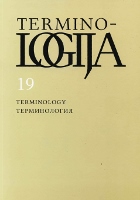Rankraštinio teisės terminų žodyno (1920 m.) lietuviški dvižodžiai terminai
Lithuanian two-word terms from the manuscript dictionary of law terms (1920)
Author(s): Alvydas UmbrasasSubject(s): Theoretical Linguistics, Applied Linguistics, Comparative Linguistics, Descriptive linguistics, Baltic Languages
Published by: Lietuvių Kalbos Institutas
Keywords: terminology history; terminology; legal terminology; terminology dictionary; two-word terms; manuscript;
Summary/Abstract: The Russian–Lithuanian manuscript Teisės terminų ir kitų reikalingų teismams žodžių žodynėlio projektas (Draft dictionary of law terms and other words necessary in court) prepared at the Ministry of Justice in 1919–1920 is a scientifically interesting object of terminology and terminography history. This article analyses two-word Lithuanian equivalents of Russian terms and other words and their combinations presented in this unpublished dictionary. There are 1723 different Lithuanian two-word combinations in this dictionary. Usually they are terms of law or word combinations which were used in the language of law at that time (not treated as terms anymore). As could be expected from the dictionary of terms the majority of word combinations presented are nominal combinations (1416). The majority of them have the form of a term. Research showed that about 600 words represent the main element of a term and about 800 words are the subordinate element. The generic terms raštas (document), teisė (law, right) and mokesnis (tax, payment, charge) in singular as well as in plural form have the largest number of specific elements. The most frequent specific elements are the words byla (case), teismas (court), and teisė (law, right) in genitive and in singular or in plural. Comparison of the frequency of the main and subordinate elements of terms shows an inverse proportionality: terms with main elements which are presented in the dictionary three or more times comprise 59 % and terms with such subordinate elements – 44 %, respectively there is 41 % of terms with the main element which occurs once or twice and 56 % of terms with such subordinate element. It is quite probable that the wider variety of subordinate elements is predetermined by the wider possibilities of expression of these elements. In addition, synonymous two-word terms usually differ in the subordinate but not the main element.
Journal: Terminologija
- Issue Year: 2012
- Issue No: 19
- Page Range: 143-172
- Page Count: 30
- Language: Lithuanian

